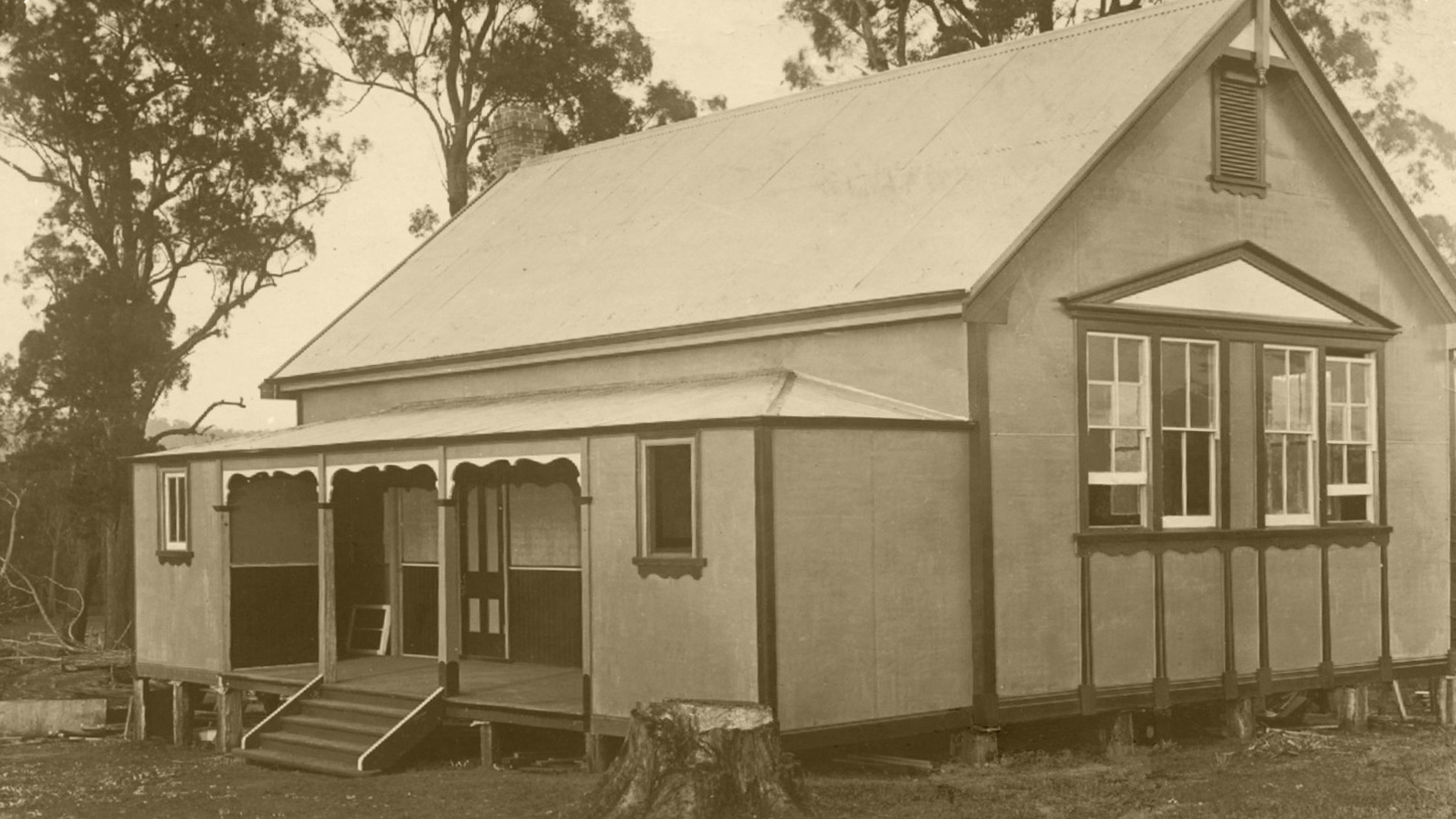During the summer vacation of 1867 in Battle Creek, Michigan, 18-year-old Edson White was employed in the type-room of the Review and Herald publishing house. On his way home one afternoon he came upon a resident from the nearby Adventist “Western Health Reform Institute” cutting firewood as part of a health recovery plan. It was 35-year-old Goodloe Bell (1832–1899), who greeted the teenager cheerily and paused for a friendly chat.1 From that one brief conversation, big things were to follow.2
They spoke again from time to time and Edson learnt that Bell was a school teacher, whereupon the young man let it be known that he was not enjoying the study of grammar, one of the leading subjects of those days, at his regular school.
Bell responded promptly with: “Grammar can be one of the most interesting studies in the world—if it is taught well.”
“Would you teach a few of us?” returned Edson.
“Yes,” replied Bell. “Come around some time.”
A few days later, there was a knock on Bell’s door, and over a dozen eager young men were found wanting to see him.
We are not told which grammatical terms were dealt with on that first occasion; however, we know that, in quick time, evening classes were arranged for young people working at the publishing house and that they were enthusiastic about the teaching skills of their new-found teacher.
It turned out that Bell, who was baptised that same year, believed he was meant to use his teaching gifts within the Seventh-day Adventist Church. With this in mind, soon after his conversation with Edson White, he moved with his family to Battle Creek. There, for a time, he was supported from tuition fees and, later, by the Battle Creek church.3 Then, an historic change took place.
Responding to an invitation by the committee running Bell’s school,4 the General Conference of the Seventh-day Adventist Church resolved to take responsibility for the conducting of this pioneering education venture. The immediate intention was to “make provision for instruction in all branches of education” for the children and young people of the immediate area. However, the longer term objective was to equip graduates of this earliest official church school for the “advancement of the cause”.5
A notable beginning in the hands of a dedicated teacher
Provided with a two-storey building (for classes below and accommodation above), Bell opened a school on June 3, 1872, with 12 students enrolled across elementary and secondary grades. In addition, a “Grammar Class [was] arranged to come at such an hour that many of the office hands [could] attend.”6
This means that, from June 3 of the present year (2022), we may look back with gratitude and enduring respect on 150 years of what is surely one of the most successful pioneering education ventures of modern times. Under God’s blessing, those 12 eager students and their intrepid, dedicated teacher, working in a single classroom, have grown, in our day, to 2,023,844 students and 113,638 teachers, working in 9419 schools—comprising the largest Protestant church school system, globally.7
As noted, back then, at mid-summer 1872, the intention was to move into a worker training program. Commitment to providing ongoing, church-sponsored schooling for the children and young people of the world-wide Adventist family had to wait a further 27 years.
By the close of the 1873 calendar year, Bell’s school was moving predictably towards catering for young men keen to go into gospel ministry within the fledgling church. They were urged to “[c]ome from your farms, from your workshops, and from your schoolrooms, and prepare yourselves for the work of the Lord”. Uriah Smith, already serving as an editor at the Review and Herald publishing house, was scheduled to lecture each day.8
With larger quarters required, in the following year an acreage was purchased in Battle Creek and building commenced.9 Battle Creek College was ready to receive its first 100 students in training from the beginning of 1875.
A monumental development spearheaded from the South Pacific Division
Following the successful launching of Battle Creek College, expansion of the Church in both America and beyond, led in the 1880s and 1890s to the opening of six worker-training colleges in the United States and a similar total number in Australia, Africa, Europe and South America. Meanwhile, though there were several short-term church schools operated by earnest Adventist families, no responsibility had been taken at official levels for the ongoing provision of schools for children in the Church.10 And this was to continue through to the closing years of the nineteenth century. Progress came about in an intriguing way.
Change was “spearhead[ed],” as church historian, Arthur Spalding, put it, from Australia. And, not by accident, this occurred while Ellen White was living in this part of the world field (1891-1900).11
The opening of the Avondale worker-training school in a rural location at Cooranbong in 1897, was a landmark attainment for the Church and the realisation of a good number of Ellen White’s hopes and goals for Adventist educational philosophy and practice. It was to be Bible-based; to offer a balance of physical, mental and spiritual development; to emphasise agriculture and other industrial pursuits; and to combine academic excellence with an ardent vision for mission service. With this work significantly accomplished, it was time for the Church to “strengthen [its] stakes” and “lengthen [its] cords” in a new direction.12
The earlier bypassing of sponsorship of church schools at official church levels should not be taken as an indication that Ellen White saw little importance in education for the formative years. In her first testimony on “proper education” (1872), she emphasised the vital role of parents, with much time to be spent with their children “in the open air amid the opening flowers and nature’s beautiful scenery”.13
Then, in her address at the opening of the Avondale School on April 28, 1897, Ellen White “told of how for years God had been calling her attention to the importance of church schools”.14 This word was shortly to be relayed to the world Church.
Over the year-end of 1898/1899, an Adventist camp meeting was called at short notice for Hamilton, a suburb of Newcastle within reach of Cooranbong, and Ellen White was one of the scheduled speakers. In the course of the camp, successful meetings were held each day for the children of the campers and for the children of interested parents living nearby. We can read today a fairly detailed description of what took place in those meetings and of the part they played in bringing about a further expansion in Adventist education, A report was written out and included as part of the sixth volume of Testimonies.15
Ellen White was prompt in acting upon the success of these children’s meetings and went on to counsel: “The good seed sown in these meetings should not be left to perish for want of care.” She went on to advocate that, “where there is a church, schools should be established if there are no more than six children to attend”. And she had the whole world in view: “This is the work to be done in America, in Australia, in Europe, and wherever companies are brought into the truth. . . The schoolroom is needed as much as the church building.”16
We are not told that Ellen White actually saw at first hand these meetings for children at the Hamilton camp; however, it is captivating to think of God’s servant making her way across the campground, walking into the children’s tent and watching the leaders telling stories from the Bible as the children follow with interest. Whether or not she saw for herself these talented teachers in action, it is evident she was impressed that the time had come to counsel Adventist churches around the globe to move into setting up this foundational level of the Church school system. Soon, in country after country, they began to spread out into provincial and rural areas. Secondary schools and academies were to follow.
With this fresh counsel on the widespread setting up of elementary/primary schools added to the work being modelled at the Avondale School there was good reason for Arthur Spalding to note that “Australasia was to become for a time the leader in educational reform and expansion.”17
A well-trained army for a long-anticipated cause
As heirs of a heaven-ordained school system set up those one-and-a-half centuries ago, we carry a privileged responsibility. There is opportunity from time to time to contribute to maintaining school facilities and resources of the highest order—to “take hold of the school work in earnest and make it what the Lord desires it to be”.18
Some of us, as staff members of one of these centres of learning, may work to make it a model of Christ-centred educational philosophy, practice and witness.

As for the students in one of these schools, they may be recruits of the “rightly trained” army of youthful workers who are to carry “the message of a crucified, risen and soon-coming Saviour” to a world blighted by “suffering and sorrow and sin”.19
At the present critical time, stalwarts already standing in the ranks may be looking to Adventist students strategically positioned in the villages, towns and cities from region after region, from country after country—a two-million-strong army—to join them in witnessing just where they are, concerning the gospel provision already made for each one of their neighbours in their corner of the earth.
Maranatha (the Lord is coming).
This article is based on an excerpt from the new devotional Listening in the Morning.
Dr Trevor Lloyd is a former Avondale College teacher/educator in retirement at Bonnells Bay, NSW.
References:
- The story is told in Goodloe Harper Bell, Pioneer Seventh-day Adventist Christian Educator, doctoral dissertation presented to Andrews University, 1982, by Allan Lindsay, pages 55ff.
- Portions of this article are adapted from Trevor Lloyd, Listening in the Morning (Warburton, Vic.: Signs Publishing Company, 2022), pages 83-88.
- See A W Spalding, Captains of the Host (Washington, DC: Review and Herald, 1949), pages 442f.
- See E M Cadwallader, “It began in Battle Creek,” Journal of Adventist Education, October-November, 1972, page 5.
- “The Proposed School,” Advent Review and Sabbath Herald, May 7, 1872, page 168.
- “The S.D.A. School,” Advent Review and Sabbath Herald, June 11, 1872, page 204. See, as well, E M Cadwallader, “It began in Battle Creek,” page 5.
- Seventh-day Adventist World Church Statistics, 2021, Statistical Report for 2020, page 91.
- “The School and the Lectures,” Advent Review and Sabbath Herald, December 23, 1873, page 16.
- In settling upon the location, the General Conference Committee chose contrary to the counsel of Ellen White who had called for a rural site allowing for training in agriculture and other “industrial enterprises.” The initial purchase in Battle Creek involved thirteen acres; however, this was reduced by way of the sale of six acres for housing lots. See A W Spalding, Captains of the Host (Washington, DC: Review and Herald, 1949), pages 445f; and A L White, “Ellen G. White and Adventist Education,” Journal of Adventist Education, October-November, 1972, page 6.
- See, for example, A W Spalding, Captains of the Host, pages 652-661. Battle Creek College commenced teacher-training in 1896-97.
- Ibid, page 647.
- The quote is from Isaiah 54:2: “Enlarge the site of your tent, and let the curtains of your habitations be stretched out; do not hold back; lengthen your cords and strengthen your stakes.” In ancient times, those following a nomadic life, would commonly live in tents made up of woven fabric or animal skins resting on cords that were stretched between stakes driven into the earth. The adding of further space under cover would involve driving heavier stakes into the earth and adding longer cords.
- Ellen G White, Testimonies for the Church (Mountain View, Ca.: Pacific Press Publishing Association, 1948, Volume 3), page 137. In this same testimony, it was counselled that “[p]arents should be the only teachers of their children until they have reached eight or ten years of age.” Thirty-two years later, after her return from Australia, Ellen White settled into her new home, “Elmshaven,” at St Helena, California, There, with a church school available, attached to the St Helena Sanitarium, Ellen White elaborated further on the matter of school-age entry. She let it be known that church schools should be available for young children and that parents should be given the option of choosing to educate their children at home or, should they not be able to manage such a situation, of having their children in a church school. A L White, Ellen G White:The Early Elmshaven Years, Volume 5, 1900-1905, (Washington, DC: Review and Herald Publishing Association, 1981), pages 313-317.
- A L White, “Ellen G. White and Adventist Education,” Journal of Adventist Education, October-November, 1972, page 11.
- Ellen G White, Testimonies for the Church (Mountain View, Ca.: Pacific Press Publishing Association, 1948, Volume 6), pages 106,107.
- Ibid, pages 107-109, 199.
- A W Spalding, Captains of the Host, pages 646, 647.
- Ellen G White, Counsels to Parents, Teachers and Students (Mountain View, Ca.: Pacific Press Publishing Association, 1913), page 167.
- Ellen G White, Education (Mountain View, Ca.: Pacific Press Publishing Association, 1903), page 271.






